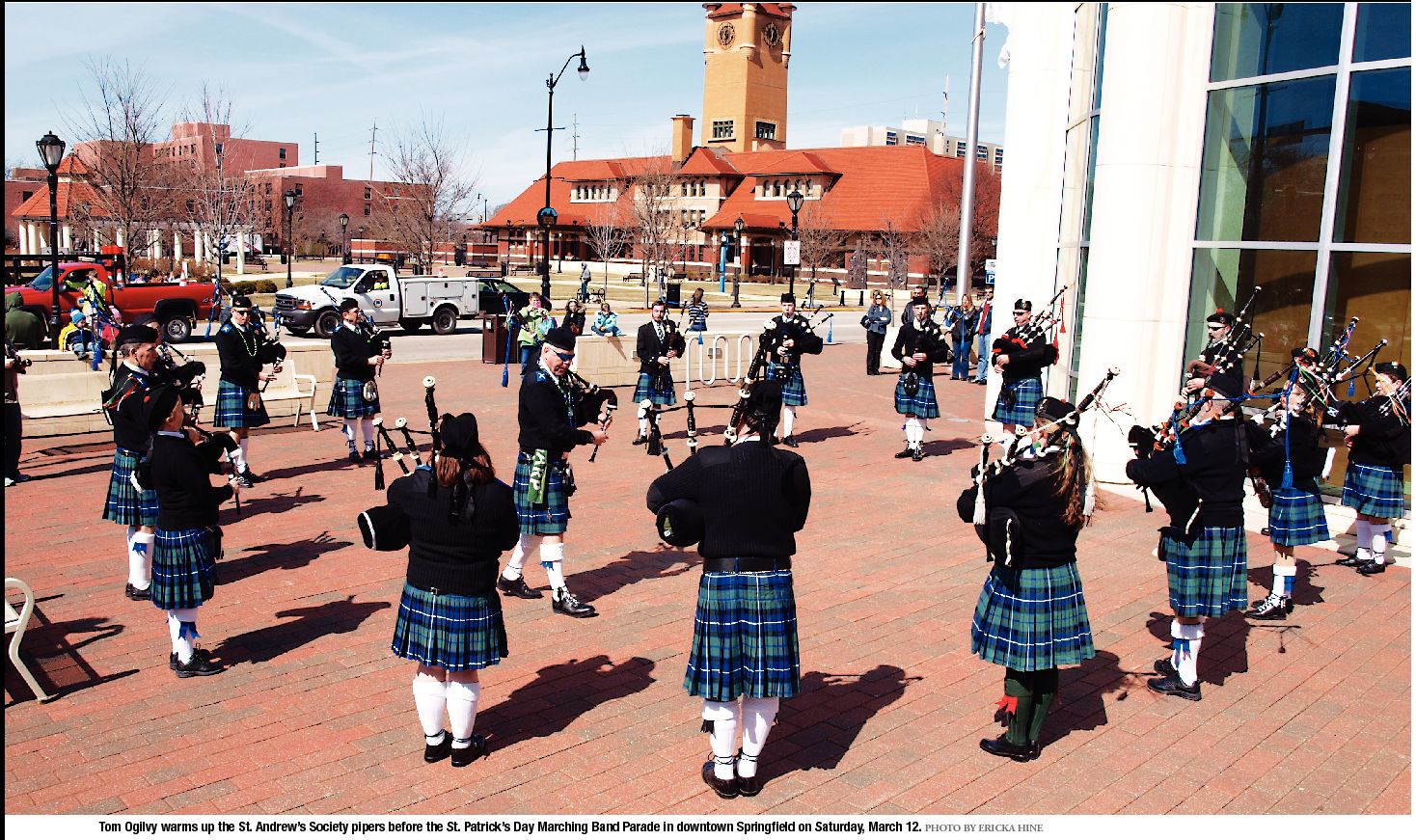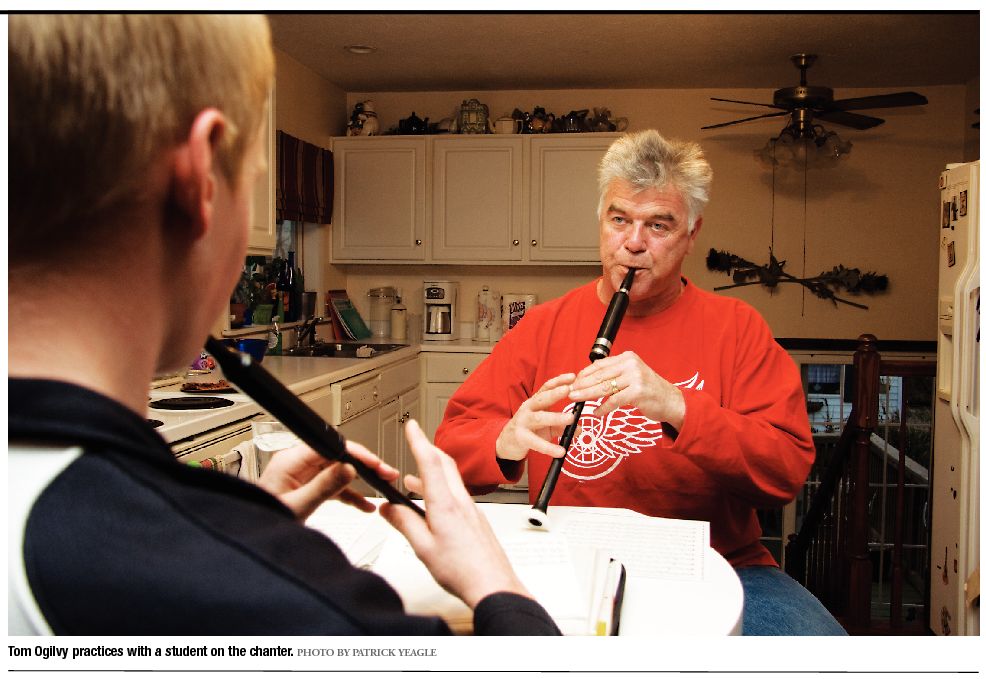
The pipes are calling
Tom and Beth Ogilvy, Springfield’s keepers of the Celtic culture
MUSIC | Tom Irwin
In our contemporary world of instant change and constant flux, generational pastimes are a lost presence, seemingly passed by for the latest and greatest new thing, barely becoming rooted before being cast aside for another practice. Will you share a Wii moment with your future grandchildren, pass on the family iPod for generations to cherish, teach the ways of proper blogging to appreciative youngsters for heritage safekeeping?
There are no immediate traditions or instantaneous customs. By definition, these things require an indefinite but undeniably lengthy amount of time to pass before becoming established long enough to achieve such a title. Beth and Tom Ogilvy, a middle-aged Springfieldbased couple, have dedicated themselves to passing on the music and dance traditions of Celtic culture through teaching and doing. In keeping these customs alive for another generation to experience and possibly prolong, they’ve discovered a joy produced from giving knowledge and helping others while improving personal talents in the process.
“Piping and dancing aren’t a hobby for us,” says Beth, who started dancing at the tender age of 3 and became a certified teacher as a young adult. “It’s not what we do, it’s who we are – daily.”
With dance classes and bagpipe lessons nearly every weekday and performances or competitions most weekends, their life together is a whirlwind of Celtic culture and that’s just how they prefer it.
“I don’t remember not doing it. My parents emigrated from Scotland,” added Tom. “I started learning the drums and bagpipes together, at about 6 1/2 or so, and stuck with the pipes.”
Their story is not only one of kindred spirits bound by national and cultural heritage, but of an honest and sincere romantic love separate from, but kindled by, the love of Celtic traditions. The couple got together in late 1998 and married in December of 1999, but before that admired each other’s talents from afar. Tom, an established and well-respected piper in the Chicago area, played for Beth and her student dancers at area gatherings and competitions.
The two naturally gravitated toward each other, drawn by the obvious mutual connection of culture. He now works at the Department of Corrections, playing the bagpipes for official functions, among other duties, while she teaches and organizes the various aspects of the family operation.
The Ogilvy enterprises originate on the home front as the couple teaches from their house and property on Old Jacksonville Road just a few miles west of Veterans Parkway. A remodeled garage in the backyard serves as the home of Ogilvy Studio (www.ogilvystudio.com) for Beth’s daily dance classes and Tom generally gives evening lessons on the bagpipes in the house. For band rehearsals they find larger and less occupied places, such as local churches, to accommodate the 10- to 20-member group of drummers and pipers.
The former garage is soundproofed for the neighbors’ protection with a special floor designed to give with the movements of the dancers. With ages ranging from toddlers to seniors and averaging some 70 students weekly,
the various levels and types of dance classes are set for different evenings of the week. Beth, a certified dance instructor, runs the only Celtic dance studio between Chicago and St. Louis and families come from Jacksonville, Litchfield, Bloomington and other areas for lessons, though most of the clientele is local.
From the Illinois State Fair to the Festival of Trees, the St. Patrick’s Day Marching Band parade to the Highland Games, small town festivals in central Illinois to national competitions in Florida, Michigan and wherever, the dancers of Ogilvy Studios get plenty of exposure and chances to practice and perform. The colorful kilts and costumes, along with the boisterous bagpipes and stylistic dancing, attract attention from an interested public.
“Recently we just got back from a competition in Florida and they want us to come back and bring the group to Daytona Beach next year,” says Beth. “I want to get us on the Queen Mary, take us all on the ship to dance and play. We have fun and people really enjoy us, you can just see it when they watch.”

Sometimes it’s not easy
letting pupils go once they’ve moved on, partly because of just missing
someone who has been a big part of your life for many years and partly
because students get involved in other things and leave without
fulfilling possible potential. The Ogilvys’ dedication brings students
close, and most stay on as friends as they move on through life, but
it’s all a process of change while teaching traditions.
“We typically can get
someone for five years, then they move on to other things, especially
with teenagers, there is just so much to do these days. Some students
have stuck with it and gone on to get college scholarships. And some
have gotten married, had kids and brought the kids back to class,” says
Beth. “I think the students who are the best challenge for us as
teachers are from 14 to 25. If they decide they want to do this in that
age group and they give themselves to this art, they are pretty unique
individuals. When grandparents drop kids off, that’s great, but if they
are of an age to choose it, they want to do it and practice.”
Lest
one think that playing the Highlandstyle bagpipes or learning the steps
of the Scottish and Irish dances are something any yokel can claim to
do, rest assured that organizations abound and officials are in place to
properly regulate these forms of ethnic selfexpression. Beth belongs to
the British Association of Teachers of Dance, Scottish Official Board
of Highland Dance and Federated United States Teacher Association and
Tom is a member of the Midwest Pipe Band Association. Both are certified
by these groups and attend necessary classes and meetings to continue
the memberships and confirm qualifications. The rules are there more for
creating the consistency necessary to establish and prolong customs
than for enforcement of protocol or insistence of etiquette.
“You have to do what the traditions require.
Irish
and Scottish dances are different in that regard. Irish I make up the
steps, but Scottish I have to go by the book they wrote 800 years ago,”
says Beth. “It is what it is. It’s a bit more than an art or a sport,
with reasons for the movements. Like the Sailor’s Hornpipe tells the
hardships of the sailor.”
Much
of the importance of learning the proper dance steps is explained in
the literary aspect of the dances. Like many actions in the artistry of
the folk world that appear simple or haphazard, they aren’t just random
movements strung together by individual performers. There is rhyme and
reason and much more.
“It’s like the Hula, each dance tells a story,” explains Tom. “There’s history behind each one too.”
“We’re
ambassadors to our culture as well as dancers,” says Beth. “I try to
get that across to our dancers, that when you go out there and do this
dance you’re not going out to just compete or because of the athletic
challenge, but because you’re carrying on the traditions of our
heritage.”
As with
other culturally based pastimes in our society, the Celtic ways of
dancing and playing music attracts those of varying ethnic backgrounds.
As in African drumming or Tae Kwon Do, belly dancing or French cooking,
Sitar playing or cricket, this American montage that we are offers the
opportunity for acquiring various ethnic traditions to all members of
the populace willing to take lessons and learn.
“Many
but not all of our dancers are of Scottish or Celtic heritage. As a
matter of fact we have several people in our organization of Polish or
German backgrounds,” says Beth. “But there’s something about the
bagpipes that we dance to, you either love them or hate them.”
“The
thing is the bagpipes are not native to Scotland or Ireland, they were
brought by the Celts and the Romans,” explains Tom. “The bagpipes
probably started somewhere in the Middle East or Egypt where there were
sheep or goats and the hard wood needed to make the reeds work. They
spread with the movement of the Celts from the Caspian Sea, who took
their pipes with them. They’ve found traces of them in the Gobi Desert.
Then they moved through Europe ending up on the edges, like in the
British Isles, Spain and Northern Africa, after getting pushed out by the Romans.”
Actually
many different cultures use bagpipes, or more literally bags with pipes
and reeds, or even more literally sheep or goatskins with hollowed
bones and wooden reeds. All bagpipes jokes aside, most of us
automatically associate the Highlands of Scotland with the stereotypical
bagpipes, but there are many types of pipes associated with different
cultures. Nearly every country in Europe and many in the Middle East and
Northern Africa has a variation on these common folk music instruments.
Most historians agree the bagpipes traveled with the Celts developing
variations from cultures where these roaming people settled. In turn
these societies mingled and intertwined, leaving many common bonds among
peoples of the world, including, perhaps, the certainly unique and
seemingly ubiquitous sound of the bagpipes.
continued on page 14